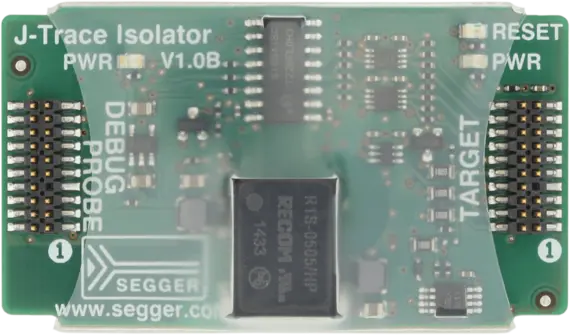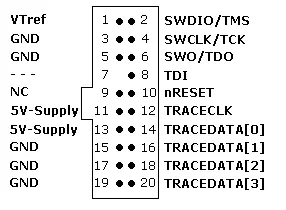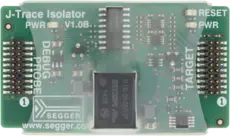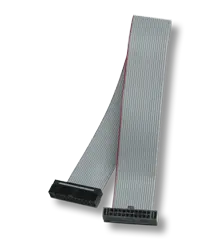J-Trace Isolator
The J-Trace Isolator can be connected between a J-Trace and any Arm board that uses the standard 19-pin Cortex-M connector to provide electrical isolation while keeping high speed trace capabilities.
Overview
The J-Trace Isolator can be connected between a J-Trace and any Arm board that uses the standard 19-pin Cortex-M connector. It provides electrical isolation while keeping high speed trace capabilities. This is essential when the development tools are not connected to the same ground as the application. It also protects the development tools from electrical spikes that often occur in some applications, such as motor control. Another typical field of application is the development of products with sensors or other analog circuitry. In this case, the J-Trace Isolator protects target hardware from electrical noise originating from the development PC. The J-Trace Isolator is compatible with J-Trace V2 or later.
Key features
- ETM trace pins fully supported up to 75 MHz trace clock
- 1 kV DC isolation
- 1.2 V - 5 V target operation supported
- Powered from emulator, only few microamps (< 25 µA) drawn from target
- JTAG standard 19-pin connection supporting TDI, TMS, TCK, TDO, RESET and SWD/SWO signals
- SWD frequency: Up to 4 MHz
- JTAG frequency: Up to 4 MHz
- 3 LEDs to indicate emulator power, target power and target RESET
Trace specification
The J-Trace Isolator supports trace clocks up to 75 MHz. For reference, the following project can be used with the Cortex-M Trace Reference Board that is included in each J-Trace package:
Download J-Trace Isolator example for Cortex-M Trace Reference Board
Faster trace clocks are beyond the specification of the digital isolator IC. Nonetheless speeds up to 120 MHz have been achieved in an example setup with this project:
https://kb.segger.com/Tracing_on_Renesas_Synergy_R7FS7G2 (testing at room temperature, with a slight adjustment of sampling delays in J-Trace PRO V2).
More information can be found here:
https://www.segger.com/products/debug-probes/j-trace/technology/setting-up-trace/
Connectors and indicators
The J-Trace Isolator uses high speed digital isolators that allow a very low propagation time between input and output. It comes with the following connectors and indicators:
- Standard .05" 19-pin Cortex-M male EMULATOR connector which needs to be connected to the emulator cable
- Standard .05" 19-pin Cortex-M male TARGET connector for connection of the target cable
- Green LED indicating power on the emulator side
- Green LED indicating power on the target side
- Red LED indicating RESET
Target connector
| Signal | Type | Description | |
|---|---|---|---|
| Pin 1 | VTref | Input | This is the target reference voltage. It is used to check if the target has power, to create the logic-level reference for the input comparators and to control the output logic levels to the target. It is normally fed from Vdd of the target board and must not have a series resistor. |
| Pin 2 | SWDIO/ TMS | I/O / Output | JTAG mode set input of target CPU. This pin should be pulled up on the target. Typically connected to TMS of the target CPU. |
| Pin 4 | SWCLK/TCK | Output | JTAG clock signal to target CPU. It is recommended that this pin is pulled to a defined state of the target board. Typically connected to TCK of the target CPU. |
| Pin 6 | SWO / TDO | Input | JTAG data output from target CPU. Typically connected to TDO of the target CPU. |
| --- | --- | --- | This pin (normally pin 7) is not existent on the 19-pin JTAG/SWD and Trace connector. |
| Pin 8 | TDI | Output | JTAG data input of target CPU.- It is recommended that this pin is pulled to a defined state on the target board. Typically connected to TDI of the target CPU. |
| Pin 9 | NC | NC | Not connected inside J-Link. Leave open on target hardware. |
| Pin 10 | nRESET | I/O | Target CPU reset signal. Typically connected to the RESET pin of the target CPU, which is typically called "nRST", "nRESET" or "RESET". |
| Pin 12 | TRACECLK | Input | Input trace clock. Trace clock = 1/2 CPU clock for Cortex-M devices. |
| Pin 14 | TRACEDATA[0] | Input | Input Trace data pin 0. |
| Pin 16 | TRACEDATA[1] | Input | Input Trace data pin 1. |
| Pin 18 | TRACEDATA[2] | Input | Input Trace data pin 2. |
| Pin 20 | TRACEDATA[3] | Input | Input Trace data pin 3. |
Pins 3, 5, 15, 17, 19 are GND pins connected to GND.
Power supply
Unlike the J-Link Isolators, the J-Trace Isolator does not have to be powered from target side. This reduces the power consumption footprint of the debug setup to < 25 µA. The emulator side powers the complete Isolator logic through pins 11 and 13.
Minimum requirements: A J-Trace PRO / J-Trace PRO Cortex-A/R/M / J-Trace PRO Cortex-M V2 or later is required to supply power to the J-Trace Isolator.
Older models might not support powering the target side through the debug interface. An overview with all software and hardware features of all our debug probe models can be found at:
https://kb.segger.com/Software_and_Hardware_Features_Overview
Preparing the J-Trace PRO to supply power
J-Trace PRO needs to supply 5 V power to the emulator side of the adapter on pin 11 and pin 13. In order to do this, you may have to configure J-Trace once as follows:
- Make sure that SEGGER J-Link software is installed on your machine. It can be downloaded from here: https://www.segger.com/downloads/jlink/
- Start J-Link Commander, which can be found under “Start -> Programs -> SEGGER -> J-Link_Vx.xxx”
- Enter the following command: power on perm
- Plug in the adapter: The LED on the emulator side should now be lit.
The red LED on the target side is lit when a Target RESET is active (low).
How to use the J-Trace Isolator with J-Trace PRO
In order to use the Isolator, follow these steps:
- Connect the Isolator with J-Trace
- Power J-Trace PRO
- Make sure the green LED on the emulator side is lit. If it is not, please follow the instructions below
- Connect the target to the target side of the Isolator
- If the target is powered, the green LED on the target side should be lit
The red LED on the target side is lit when a Target RESET is active (low).
How to use the J-Trace Isolator with another Arm emulator
The J-Trace Isolator has been designed for J-Trace V2 or later, but can also be used with other Arm emulators with the same pinout. In this case, you should make sure that 5 V are supplied to pin 19 of the emulator connector and that your emulator is not damaged when applying 5 V to this pin. Do this at your own risk!
Safety
This isolator provides basic isolation only. Do not use with hazardous voltages without further protection measures to avoid risk of electrical shock and fire.
SEGGER isolators provide basic isolation to withstand high voltages as mentioned in the resp. technical data section. To protect people when dealing with potentially hazardous voltages, it is mandatory to have a second protection measure in place in case the first insulation barrier fails. This is called double or reinforced isolation. How this double isolation is achieved depends on the use case or application setup. Also check your local safety related directives valid for your country to make sure all requirements are met.




